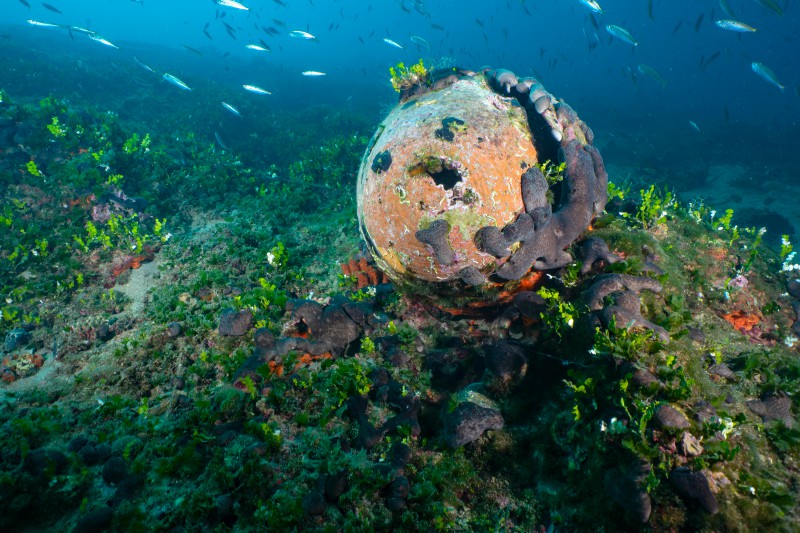Talking to Greek News Agenda, the director of the Hellenic Ephorate of Underwater Antiquities Ms Pari Kalamara announced that four shipwrecks in the Pagasetic gulf which date back to Classical and Byzantine times are set to become underwater museums, noting that this is “a small but essential step towards the opening of sea archaeological sites…”
Focusing on the positive aspects of the initiative, Ms Kalamara said that:
• It leads to the development of a form of alternative tourism, with all the positive economic consequences implied for the local economy and society.
• It highlights the cultural heritage and nautical history of our country, and will contribute to the better protection of marine monuments of Greece.
The underwater museums are realized in the framework of the BLUEMED European project, an initiative offering a shared strategic framework for working towards a healthy, productive and resilient Mediterranean Sea that is better known and valued. It is designed to tap the full potential of the marine and maritime sectors, structuring transnational cooperation to create new ‘blue’ jobs and to promote and improve social well being, sustainable prosperity and the environmental status of the region and its surroundings.
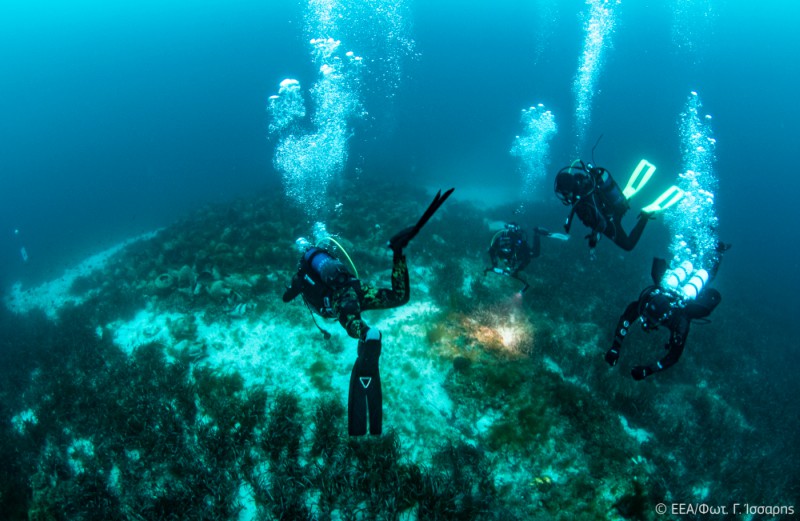 Visitors at the shipwreck of Peristera on its “open to public” weekend (6-7 April) ©Ministry of Culture and Sports- Ephorate of Underwater Antiquities, photo by G. Issaris
Visitors at the shipwreck of Peristera on its “open to public” weekend (6-7 April) ©Ministry of Culture and Sports- Ephorate of Underwater Antiquities, photo by G. Issaris
The sites that will be accessible for visitors are: the wreck on the island of Peristera near Alonissos (5th century BC); the Byzantine wreck on the islet of Kikinthos (dating back to the 9th – 13th century); the shipwreck at Akra Glaros (Byzantine period) and the wreck at Telegraphos (4th century AD). Diving to a depth of up to 40 metres under the sea will be allowed in all underwater museums and visitors will be accompanied by divers and archaeologists. For those who do not wish to dive, they can visit the shipwrecks by boarding special boats. According to the information kindly provided to GNA by Dr Kalamara, which will also be available on the BLUEMED project website, the shipwrecks have the following characteristics:
Alonissos –Peristera
Peristera is an islet near Alonissos in the North Sporades, a cluster of islands in Greece on the central Aegean Sea.
The shipwreck was located at the north of Kokkalia bay near the west rocky coast of Peristera. It was discovered by the fisherman and inhabitant of the island Dimitris Maurikis, and brought to the attention of the Ephorate of Underwater Antiquities in 1985. The shipwreck was excavated by Dr Elpida Hadjidaki, archaeologist and Head of the Ephorate, during 1992-1993, 1999, 2000-2001.
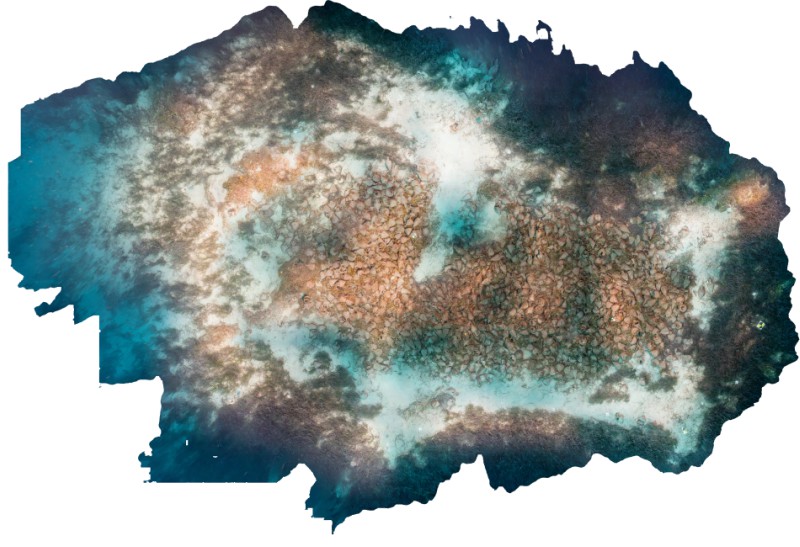 Orthophotomosaic of the shipwreck of Peristera ©Ministry of Culture and Sports- Ephorate of Underwater Antiquities, photo by Matteo Collina Univerità della Calabria –DIMEG
Orthophotomosaic of the shipwreck of Peristera ©Ministry of Culture and Sports- Ephorate of Underwater Antiquities, photo by Matteo Collina Univerità della Calabria –DIMEG
This large wooden merchant ship dates to the last quarter of the 5th century BC,on the basis of the artifacts and the transport amphorae recovered. This merchant ship of the classical period is considered to be one of the largest of that era and at the same time evidence of the importance of trade in the classical period. It is estimated that it was able to carry three to four thousand amphorae, which were one of the main trade products in antiquity. The cargo was mainly composed of transport amphorae (ceramic vessels used for the transportation and storage of foodstuffs), mostly the so called “Mendean” type transport amphorae, as well as the “Peparithian” type [probably produced in ancient Peparithos, now Skopelos]. Wine and oil were two of the chief products transported in ancient times, especially with transport amphorae, as well as other products such as pottery, grain, wood, etc. These precious products probably constituted the main cargo of the ship.
Kikinthos –West Pagasetic gulf
The islet of Kikinthos is a natural breakwater, lying at the east of Amaliapolis bay, on the west side of the Pagasetic gulf. In antiquity, Kikinthos was used as quarantine (like Spinalonga in Crete) for the seamen returning to Amaliapolis from their voyages. They stayed on Kikinthos for a month and if they survived they returned to their homes. The rest who didn’t make it were buried on the islet.
The shipwreck was located in the course of underwater survey conducted in 2005 at the northwestern end of Kikinthos islet, under the auspices of Hellenic Institute of Marine Archaeology and the direction of marine archaeologist Elias Spondylis.
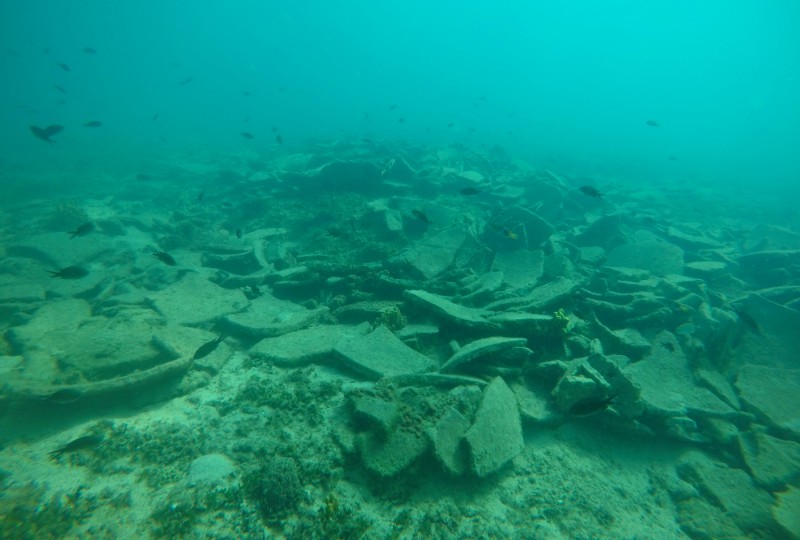 Kikinthos –West Pagasetic gulf, fragments of pithoi ©Ministry of Culture and Sports- Ephorate of Underwater Antiquities
Kikinthos –West Pagasetic gulf, fragments of pithoi ©Ministry of Culture and Sports- Ephorate of Underwater Antiquities
The remnants of a Byzantine shipwreck cargo of mainly pithoi (large storage containers) are located at around 3 to 11 metres from the seabed. An area of around 8 x 6 metres is covered by big pithos shards that can be attributed to at least three different types according to Elias Spondylis. Among the pithoi there are also shards of two types of amphorae, dating to the 12th – 13th centuries AD. The pithoi types are attributed to the 8th – 9th centuries AD, but it seems that they coexist with the later amphorae due to the fact that storage vessels were usually used for long periods of time.
Akra –Glaros
Akra Glaros Cape is located in an area opposite of Nies, a coastal village in the prefecture of Magnesia and close to the city of Amaliapolis. Amaliapolis or Mitzela (local name, which means Small Mountain in the woods) is located near Almiros and 54 kilometers from Volos, on the western coast of the Pagasetic Gulf.
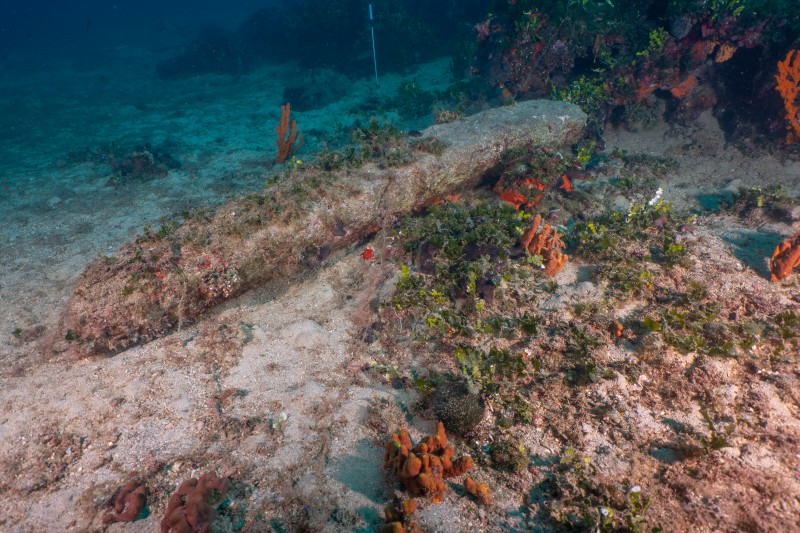 Glaros, West Pagasetic gulf, archaic stone anchor stock ©Ministry of Culture and Sports- Ephorate of Underwater Antiquities, photo by Matteo Collina Univerità della Calabria –DIMEG
Glaros, West Pagasetic gulf, archaic stone anchor stock ©Ministry of Culture and Sports- Ephorate of Underwater Antiquities, photo by Matteo Collina Univerità della Calabria –DIMEG
According to the Hellenic Institute of Marine Archaeology that investigates the area from 2000 to the present under the direction of marine archaeologist Elias Spondylis, at least four shipwrecks were recognized: a Hellenistic one (3rd – 2nd century BC), an Early Roman one (1st – 2nd century AD) and two of Middle and Late Byzantine (12th – 13th century AD) where Late Roman pottery is also present. The finds related to the aforementioned shipwrecks are so dispersed and mixed that the description of the different shipwrecks is a really difficult and not yet concluded task. On the other hand, it is really worth visiting the site and diving among the plentiful and varying objects indicative of ancient cargoes and dangerous journeys.
Telegrafos
Telegrafos Bay is located in the prefecture of Magnesia and close to the city of Amaliapolis. Nowadays the town has turned into a holiday centre attracting many tourists, local and foreign. Visitors can admire the picturesque stores, visit the castle and walk the lovely paths.
The shipwreck was first located in 2000 by the team of the Hellenic Institute of Marine Archaeology which surveyed the area of the south-western coastof the Pagasetic Gulf, and it was later fully excavated from 2003 to 2008, also by HIMA, under the direction of marine archaeologist Elias Spondylis.
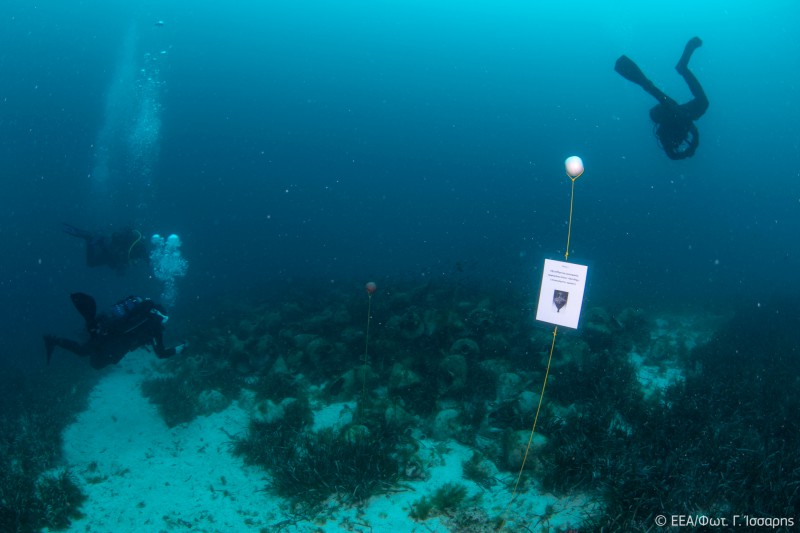 Visitors at the shipwreck of Peristera on its “open to public” weekend (6-7 April) ©Ministry of Culture and Sports- Ephorate of Underwater Antiquities, photo by G. Issaris
Visitors at the shipwreck of Peristera on its “open to public” weekend (6-7 April) ©Ministry of Culture and Sports- Ephorate of Underwater Antiquities, photo by G. Issaris
The initial picture was of an intact shipwreck caused possibly by the ship’s crushing against the rocky coast and capsizing. Unfortunately, the site was looted before the excavation. Despite that, the excavation brought to light the rest of the cargo and a thorough study led to the recognition of three main types of Late Roman (4th century AD) amphorae for the main cargo that could be attributed northern Peloponnesian (Corinth) and Eastern Aegean (Samos) origin. Facts indicate a ship travelling along the sea routes of the Late Roman – newly established Byzantine Empire across and along the sides of the Aegean Sea. Moreover, together with the main cargo smaller amounts of amphorae of six different types point to probable stops at minor ports along the route connecting the western side of the Aegean or even different products from secondary landing points.
It is worth noting that the BLUEMED project aims to promote the “blue economy” of the Mediterranean and to identify best practices for the protection and promotion of underwater cultural heritage, the ultimate goal being making such sites accessible to the public.
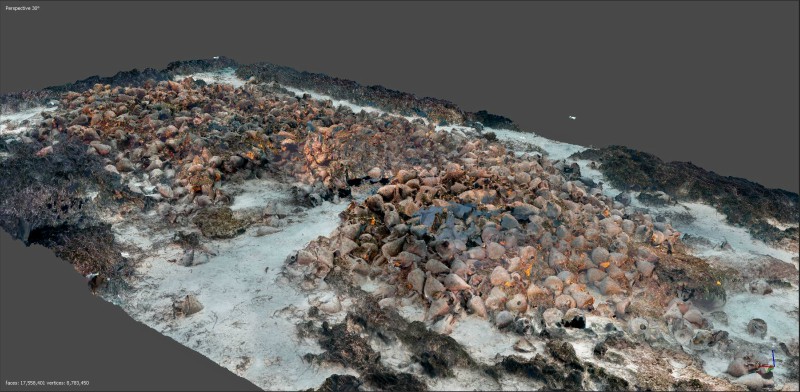 Three-dimensional side-view of the shipwreck of Peristera ©Ministry of Culture and Sports- Ephorate of Underwater Antiquities, photo by Matteo Collina Univerità della Calabria –DIMEG
Three-dimensional side-view of the shipwreck of Peristera ©Ministry of Culture and Sports- Ephorate of Underwater Antiquities, photo by Matteo Collina Univerità della Calabria –DIMEG
Additionally, the Hellenic Ephorate of Underwater Antiquities is intensively working towards:
- The formation of an operative framework for the underwater museums
- Ensuring the means required for their operation, such as logistics, technological equipment, human resources, etc.
- The establishment of indicators for monitoring the status of archeological sites
- The introduction of a procedure for the approval of each study
- The local community’s access to information about the project in order to embrace it and the promotion of these sites to the diving community.
Marianna Varvarrigou (Intro photo: Glaros, West Pagasetic Gulf, Byzantine amphora ©Ministry of Culture and Sports- Ephorate of Underwater Antiquities, photo by Matteo Collina Univerità della Calabria –DIMEG)
Read also via Greek News Agenda: Antony Gormley installation on the island of Delos; Professor Michael Scott: By studying the ancient Greeks we learn more about ourselves; Study Archaeology in Greece: English-taught Undergraduate and Postgraduate Courses; Greece among EU’s “big five” in blue economy
TAGS: MARITIME ARCHAEOLOGY

